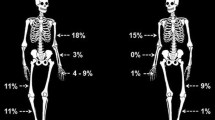Abstract.
In this study, bone feature parameters were obtained from digital lumbar vertebral images to determine their potential usefulness in assessing binary trabecular skeletal patterns. The system consisted of a magnification radiographic technique, computed radiography (CR), microfocused X-ray computed tomography (μ-CT), and mathematical morphology image processing. A digital CR image was produced, using a ten-times magnified lumbar vertebral cancellous bone block (1.5 × 1.5 × 1.5 cm3). The information was then subjected to mathematical morphology image processing, to extract eight binary trabecular skeletal patterns having different continuities as the operation number (n) increased. These skeletal patterns were used as test patterns and analyzed quantitatively by calculation of the skeletal pixel percentage (SKP) and star volume analysis (Vsk, volume of skeletal trabecular elements; Vsp, volume of nonskeletal elements). Then the binary skeletal pattern data were converted into the μ-CT format, using a general personal computer, and the images were quantitatively analyzed with μ-CT built-in image analysis software for microstructural indices, fractal dimension analysis, and node-strut analysis. The SKP and Vsk showed an expected decrease as n increased. Concurrently, the Vsp showed an expected increase as n increased. The skeletal thickness (Sk.Th) showed a constant value at n= 1 to 4 and n= 5 to 7, but decreased in a stepwise fashion at n= 1 and n= 5. The skeletal number (Sk.N), bone area fraction (B.Ar/T.Ar) and bone perimeter fraction (B.Pm/T.Ar), decreased as n increased. Skeletal space (Sk.Sp) and perimeter-to-area ratio (B.Pm/B.Ar) increased with increasing n. In the fractal dimension analysis, the values decreased with increasing n and showed changes similar to the image observations. In fact, the SKP, star volume analysis, Sk.N, B.Ar/T.Ar, B.Pm/T.Ar, Sk.Sp, and B.Pm/B.Ar all closely mirrored the observational analysis of the images. Linkage of the skeletal structure as functions of the following parameters could be quantitatively demonstrated. The parameters used were node (Nd) and terminus (Tm). Variations in the total strut length (TSL) and Tm could demonstrate quantitative changes in skeletal structure. These results indicate that the system consisting of a combination of a magnification radiographic technique, CR, μ-CT, and mathematical morphology image processing may be a useful tool for quantitative skeletal structure analysis and the structural assessment of lumbar vertebrae, for the assessment of skeletal structural changes. It is important to choose suitable parameters for the desired structural changes.
Similar content being viewed by others
Author information
Authors and Affiliations
Additional information
Received: November 2, 2001 / Accepted: December 20, 2001
About this article
Cite this article
Oka, K., Kumasaka, S. & Kashima, I. Assessment of bone feature parameters from lumbar trabecular skeletal patterns using mathematical morphology image processing. J Bone Miner Metab 20, 201–208 (2002). https://doi.org/10.1007/s007740200029
Issue Date:
DOI: https://doi.org/10.1007/s007740200029




